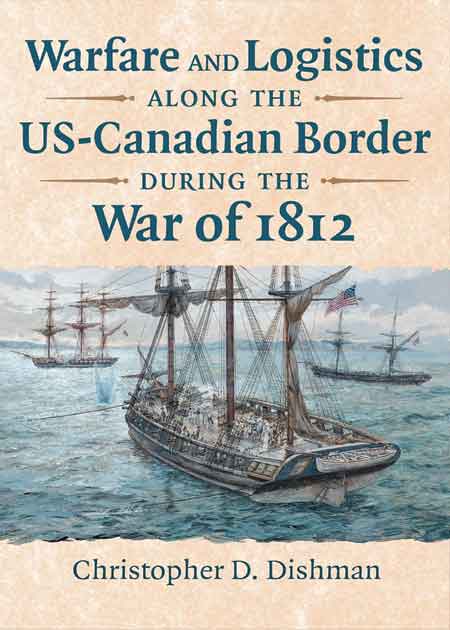By Christopher D. Dishman.
Lawrence: University Press of Kansas, 2021.
ISBN 978-0-70063-270-1.
Illustrations. Maps. Notes. Bibliography. Index.
Pp. xviii, 334. $39.95.
Although not academically trained as a historian, Christopher Dishman has written a lively and very informative military account of the difficulties experienced by both British and American military leaders during the War of 1812 along the U.S.-Canadian border. Readers who are already familiar with the battles and skirmishes in this hotly contested region will find the usual discussion of the major battles and important military leaders. What they may find new and illuminating is the use of little-known sources, particularly Canadian, in telling the story of these campaigns.
Dishman demonstrates how important the interrelationship between land and naval forces to this theater was. As the title of the book implies, Dishman’s main focus is on how the strategy of each belligerent was affected by the means of supplying its armies over a vast territory. A poorly developed road network proved no substitute for moving supplies by water. Consequently, the waterways connecting the British naval base in Halifax with remote inland forts such as Malden and Michilimackinac—a distance of over 1,500 miles—were vital to Britain’s defense of Canada. Because of the lack of good roads as an alternative means of moving men and supplies, naval superiority on the Great Lakes became an absolute necessity. This reality affected the British more so than American efforts. Many naval supplies that were needed to build and maintain new ships on the waterways at Kingston and York (Toronto) had to come from Halifax and often from faraway Britain. As Dishman keenly points out, British forces were extended over a much longer route while American forces could move vertically north and south over much shorter routes. The lengthy lifeline for the British from the St. Lawrence to Lake Superior made it highly vulnerable to be intercepted by American forces.
In comparison, Dishman states that American shipbuilding on the Great Lakes could be supplied with iron works and other naval industries in (relatively) nearby Pittsburgh and Philadelphia. This should have given the Americans a greater advantage in its logistical supply. Dishman reviews the attempts of American forces to invade Canada in 1813 and 1814. In each campaign, American forces were unable to coordinate its attacks on both Lower and Upper Canada to a degree that this material advantage was neutralized.
Interpersonal squabbles between American generals made it near impossible for a concerted attack on the British lifeline that could have led to the taking of Montreal and Kingston. Capture of these vital ports would have spelled disaster for the British in the winter of 1813-14. Dishman also points out that British crews and the ships themselves were often rushed into the service before the crews were properly trained and contributed to defeat at Lake Erie and on Lake Champlain.
Dishman also addresses two other points: the possibility of the Duke of Wellington going to America and the general criticism of Governor General Sir George Prevost’s handling of the war effort, especially his failure to invade New York in September 1814. Wellington made it clearly understood that he saw no advantage of his going to America without complete control over the Great Lakes which British forces could not guarantee. Although Prevost’s invasion of September 1814 failed due primarily to the loss of naval power on Lake Champlain, Dishman points out that Prevost accomplished his overall mission—the defense of Canada—given what men and materiel he had at his disposal.
The book is skillfully written and ably presented in a generally chronological narrative. It is a very balanced look at both sides. A series of maps depicting the theater of operations on the U.S.-Canadian frontier along with some localized maps at the front of the volume are very useful to the reader to follow the narrative. Since Dishman refers to certain major battles in some detail, perhaps a few maps of the individual battles would have been as useful as well.
Stuart L. Butler
Williamsburg, Virginia
